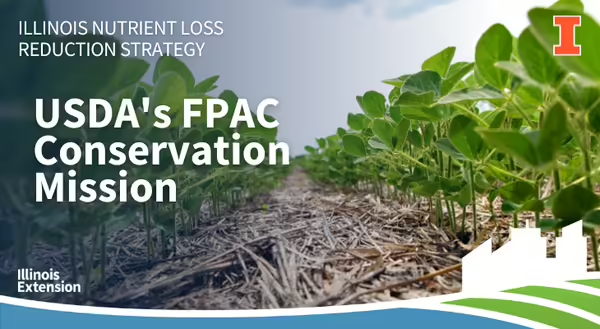
Undersecretary for Farm Production and Conservation, Robert Bonnie, met with National Association of Farm Broadcasting members in Washington D.C. The group was able to ask Undersecretary Bonnie questions about the Farm Production and Conservation’s (FPAC) conservation mission. Undersecretary Bonnie spoke to the group about many topics including the Inflation Reduction Act, the upcoming Farm Bill, climate-smart agriculture, carbon markets, and climate change.
Inflation Reduction Act
The Inflation Reduction Act (IRA) was signed into law in August 2022 and allocated $18 billion for agricultural conservation funding over the next 10 years for four existing USDA programs – EQIP, CSP, CRP, and RCPP. Within each program, a list of potentially funded practices has been developed, with the ability to be flexible and add more practices over time. Money is available for cost-share for the approved conservation practices, technical assistance, and measurement and verification of the practices. Undersecretary Bonnie pointed out that there is a lot of overlap in climate-smart practices with co-benefits like improved wildlife habitat, soil resilience, and water quality. USDA will continue to look for ways to promote those practices.
Farm Bill
After Congress passed the IRA, one of the potential issues recognized was the Farm Bill coming up this year, and the money allocated under the IRA, although a separate pot, might be used to fulfill some of the Farm Bill obligations. Work on the upcoming Farm Bill is also to set a budget and identify priority areas. The current administration is supportive of resources allocated in Farm Bill being focused on climate mitigation.
Climate-smart agriculture and forestry
There were two items of concern that Bonnie was asked about related to climate-smart agriculture, one of them was whether these programs would be voluntary or mandatory, and the other was about the collection of data to prove the value of the program. Undersecretary Bonnie emphasized that the administration understands the importance of voluntary, incentive-based collaborative efforts. He went on to explain how regulatory approaches are not an effective way to have individuals buy into conservation. Data collection will be critical for both producers and the public to demonstrate the voluntary adoption approach can work.
Farmers make decisions on what practices they want to adopt. These practices need to be supported by data and incentives. Undersecretary Bonnie pointed out the need to tap into what farmers are already doing and not penalize the early adopters. These practices must make economic and agronomic sense. He also pointed out that partnerships are vital to get more conservation on the ground and to encourage local conversations that can transition to larger-scale adoption of these conservation practices.
Carbon markets
There are multiple approaches to encourage private capital to come into agriculture to support climate solutions. There are voluntary markets currently available and those markets may be an important tool. Bonnie acknowledged the role of USDA in this process is to provide incentives and data to partners in agriculture and forestry to help move those solutions forward and prove that this approach works. Furthermore, Undersecretary Bonnie recognized that carbon markets can be one part of the solution but are not the only solution.
Climate change
There can be an alignment between agriculture and climate. Many agronomic practices can improve production and have a beneficial impact on climate. Undersecretary Bonnie highlighted that U.S. agriculture is more efficient than other parts of the world and that through this efficiency U.S. agriculture can produce more using few resources and producing less greenhouse gases, which can plan a role in the climate solution. The USDA is working to promote a model that rewards outcomes and creates incentives for those outcomes while allowing innovation. Undersecretary Bonnie continued to reiterate the need for a voluntary approach and the need for farmers to be a partner in the solution.
Undersecretary Bonnie addressed other topics including messaging conservation to the public, the need for data collection and research investment, and the concern about taking farmland out of production in his interview. Listen to the full interview at go.illinois.edu/NLRS_Episode52.
About the authors
Rachel Curry is a Watershed Outreach Associate for two Nitrogen Priority Watersheds (Flint-Henderson and Lower Rock River Watersheds) and is housed in the Galva office of the Henry, Mercer, Rock Island, and Stark Counties Extension Unit. Rachel earned a BS in Environmental Studies from Knox College and an MS in Environmental Science and Soil Science from Iowa State University with an emphasis on soil fertility. She is interested in sharing information on the Illinois Nutrient Loss Reduction Strategy and agricultural conservation practices through discussion and outreach.
Nicole Haverback is a Watershed Outreach Associate for two Phosphorus Priority Watersheds (Embarras and Little Wabash River Watersheds) and is housed in the Effingham office of the Clay, Effingham, Fayette, and Jasper Counties Extension Unit. Nicole earned a BS in Agriculture and Rural Policy Studies from Iowa State University in May of 2022. She is interested in sharing information on the Illinois Nutrient Loss Reduction Strategy and agriculture conservation practices through discussion and outreach.
About the blog
At Illinois Extension, we’re working to improve water quality at home and downstream. Every month, our watershed outreach associates will bring you stories highlighting agricultural conservation practices, current research projects and results, and from the field farmer interviews. The Nutrient Loss Reduction blog covers conservation practices recommended by the Illinois Nutrient Loss Reduction Strategy, timely updates, farm safety, and new decision tools to help farmers and producers reduce the nutrients leaving their field. Want to get notified when new blog posts are available? Subscribe at go.illinois.edu/SubscribeINLRS.